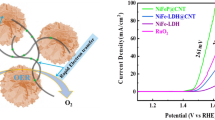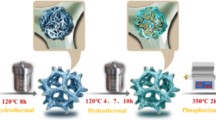Abstract
Next-generation catalysts for water splitting are crucial towards a renewable hydrogen economy. MoS2 and WS2 represent earth-abundant, noble metal cathode alternatives with high catalytic activity at edge sites. One challenge in their development is to nanostructure these materials in order to achieve increased performance through the creation of additional edge sites. In this work, we demonstrate a simple route to form nanostructured-WS2 using sonochemical exfoliation to break interlayer and intralayer bonds in WS2 nanotubes. The resulting few-layer nanoflakes are ∼100 nm wide with a high density of edge sites. WS2 nanoflakes are utilized as cathodes for the hydrogen evolution reaction (HER) and exhibit superior performance to WS2 nanotubes and bulk particles, with a lower onset potential, shallower Tafel slope and increased current density. Future work may employ ultra-small nanoflakes, dopant atoms, or graphene hybrids to further improve electrocatalytic activity.

Similar content being viewed by others
References
Chhowalla, M.; Shin, H. S.; Eda, G.; Li, L.-J.; Loh, K. P.; Zhang, H. The chemistry of two-dimensional layered transition metal dichalcogenide nanosheets. Nat. Chem. 2013, 5, 263–275.
Wang, Q. H.; Kalantar-Zadeh, K.; Kis, A.; Coleman, J. N.; Strano, M. S. Electronics and optoelectronics of two-dimensional transition metal dichalcogenides. Nat. Nanotechnol. 2012, 7, 699–712.
Alivisatos, A. P. Perspectives on the physical chemistry of semiconductor nanocrystals. J. Phys. Chem. 1996, 100, 13226–13239.
Jaramillo, T. F.; Jørgensen, K. P.; Bonde, J.; Nielsen, J. H.; Horch, S.; Chorkendorff, I. Identification of active edge sites for electrochemical H2 evolution from MoS2 nanocatalysts. Science 2007, 317, 100–102.
Bonde, J.; Moses, P. G.; Jaramillo, T. F.; Nørskov, J. K.; Chorkendorff, I. Hydrogen evolution on nano-particulate transition metal sulfides. Faraday Discuss. 2009, 140, 219–231.
Kibsgaard, J.; Chen, Z.; Reinecke, B. N.; Jaramillo, T. F. Engineering the surface structure of MoS2 to preferentially expose active edge sites for electrocatalysis. Nat. Mater. 2012, 11, 963–969.
Li, Y.; Wang, H.; Xie, L.; Liang, Y.; Hong, G.; Dai, H. MoS2 nanoparticles grown on graphene: An advanced catalyst for the hydrogen evolution reaction. J. Am. Chem. Soc. 2011, 133, 7296–7299.
Gutiérrez, H. R.; Perea-López, N.; Elías, A. L.; Berkdemir, A.; Wang, B.; Lv, R.; López-Urías, F.; Crespi, V. H.; Terrones, H.; Terrones, M. Extraordinary room-temperature photoluminescence in WS2 monolayers. arXiv:1208.1325 [cond-mat.mes-hall], 2012.
Brorson, M.; Carlsson, A.; Topsoe, H. The morphology of MoS2, WS2, Co-Mo-S, Ni-Mo-S and Ni-W-S nanoclusters in hydrodesulfurization catalysts revealed by HAADF-STEM. Catal. Today 2007, 123, 31–36.
Wu, Z.; Fang, B.; Bonakdarpour, A.; Sun, A.; Wilkinson, D. P.; Wang, D. WS2 nanosheets as a highly efficient electrocatalyst for hydrogen evolution reaction. Appl. Catal. B: Environ. 2012, 125, 59–66.
Bhandavat, R.; David, L.; Singh, G. Synthesis of surface-functionalized WS2 nanosheets and performance as Li-ion battery anodes. J. Phys. Chem. Lett. 2012, 3, 1523–1530.
Voiry, D.; Yamaguchi, H.; Li, J.; Silva, R.; Alves, D. C. B.; Fujita, T.; Chen, M.; Asefa, T.; Shenoy, V.; Eda, G.; et al. Enhanced catalytic activity in strained chemically exfoliated WS2 nanosheets for hydrogen evolution. arXiv:1212.1513, 2013.
Matte, H. S. S. R.; Gomathi, A.; Manna, A. K.; Late, D. J.; Datta, R.; Pati, S. K.; Rao, C. N. R. MoS2 and WS2 analogues of graphene. Angew. Chem. Int. Ed. 2010, 49, 4059–4062.
Tenne, R.; Margulis, L.; Genut, M.; Hodes, G. Polyhedral and cylindrical structures of tungsten disulphide. Nature 1992, 360, 444–446.
Zak, A.; Sallacan-Ecker, L.; Margolin, A.; Feldman, Y.; Popovitz-Biro, R.; Albu-Yaron, A.; Genut, M.; Tenne, R. Scaling up of the WS2 nanotubes synthesis. Fuller. Nanotube. Car. N. 2011, 19, 18–26.
Jiao, L.; Wang, X.; Diankov, G.; Wang, H.; Dai, H. Facile synthesis of high-quality graphene nanoribbons. Nat. Nanotechnol. 2010, 5, 321–325.
Zhou, K.-G.; Mao, N.-N.; Wang, H.-X.; Peng, Y.; Zhang, H.-L. A mixed-solvent strategy for efficient exfoliation of inorganic graphene analogues. Angew. Chem. Int. Ed. 2011, 50, 10839–10842.
Yang, D.; Frindt, R. F. Li-intercalation and exfoliation of WS2. J. Phys. Chem. Sol. 1996, 57, 1113–1116.
Krause, M.; Viršek, M.; Remškar, M.; Sallacan, N.; Fleischer, N.; Chen, L.; Hatto, P.; Kolitsch, A.; Möller, W. Diameter and morphology dependent Raman signatures of WS2 nanostructures. ChemPhysChem 2009, 10, 2221–2225.
Krause, M.; Viršek, M.; Remškar, M.; Kolitsch, A.; Möller, W. Diameter dependent Raman scattering of WS2 nanotubes. Phys. Status. Solidi. B 2009, 246, 2786–2789.
Feldman, Y.; Frey, G. L.; Homyonfer, M.; Lyakhovitskaya, V.; Margulis, L.; Cohen, H.; Hodes, G.; Hutschinson, J. L.; Tenne, R. Bulk synthesis of inorganic fullerene-like MS2 (M = Mo, W) from the respective trioxides and the reaction mechanism. J. Am. Chem. Soc. 1996, 118, 5362–5367.
Molina-Sanchez, A.; Wirtz, L. Phonons in single-layer and few-layer MoS2 and WS2. Phys. Rev. B 2011, 84, 155413.
Lee, C.; Yan, H.; Brus, L. E.; Heinz, T. F.; Hone, J.; Ryu, S. Anomalous lattice vibrations of single- and few-layer MoS2. ACS Nano 2010, 4, 2695–2700.
Wieting, T. J.; Verble, J. L. Interlayer bonding and lattice-vibrations of β-GaSe. Phys. Rev. B 1972, 5, 1473–1479.
Staiger, M.; Rafailov, P.; Gartsman, K.; Telg, H.; Krause, M.; Radovsky, G.; Zak, A.; Thomsen, C. Excitonic resonances in WS2 nanotubes. Phys. Rev. B 2012, 86, 165423.
Coehoorn, R.; Haas, C.; Dijkstra, J.; Flipse, C. J. F. Electronic-structure of MoSe2, MoS2, and WSe2. 1. Band-structure calculations and photoelectron spectroscopy. Phys. Rev. B 1987, 35, 6195–6202.
Coehoorn, R.; Hass, C.; de Groot, R. A. Electronic structure of MoSe2, MoS2, and WSe2. II. The nature of the optical band gaps. Phys. Rev. B 1987, 35, 6203–6206.
Mak, K. F.; Lee, C.; Hone, J.; Shan, J.; Heinz, T. F. Atomically thin MoS2: A new direct-gap semiconductor. Phys. Rev. Lett. 2010, 105, 136805.
Frey, G. L.; Elani, S.; Homyonfer, M.; Feldman, Y.; Tenne, R. Optical-absorption spectra of inorganic fullerenelike MS2 (M = Mo, W). Phys. Rev. B 1998, 57, 6666–6671.
Kam, K. K.; Parkinson, B. A. Detailed photocurrent spectroscopy of the semiconducting group-VI transitionmetal dichalcogenides. J. Phys. Chem. 1982, 86, 463–467.
Ding, Y.; Wang, Y.; Ni, J.; Shi, L.; Shi, S.; Tang, W. First principles study of structural, vibrational and electronic properties of graphene-like MX2 (M = Mo, Nb, W, Ta; X = S, Se, Te) monolayers. Physica B 2011, 406, 2254–2260.
Chen, Z.; Cummins, D.; Reinecke, B. N.; Clark, E.; Sunkara, M. K.; Jaramillo, T. F. Core-shell MoO3-MoS2 nanowires for hydrogen evolution: A functional design for electrocatalytic materials. Nano Lett. 2011, 11, 4168–4175.
Liang, Y.; Li, Y.; Wang, H.; Dai, H. Strongly coupled inorganic/nanocarbon hybrid materials for advanced electrocatalysis. J. Am. Chem. Soc. 2013, 135, 2013–2036.
Wang, H.; Dai, H. Strongly coupled inorganic-nano-carbon hybrid materials for energy storage. Chem. Soc. Rev. 2013, 42, 3088–3113.
Author information
Authors and Affiliations
Corresponding author
Electronic supplementary material
Rights and permissions
About this article
Cite this article
Choi, C.L., Feng, J., Li, Y. et al. WS2 nanoflakes from nanotubes for electrocatalysis. Nano Res. 6, 921–928 (2013). https://doi.org/10.1007/s12274-013-0369-8
Received:
Revised:
Accepted:
Published:
Issue Date:
DOI: https://doi.org/10.1007/s12274-013-0369-8




